Built for speed and agility, modern-day sport bikes are a feat of engineering, and tires play a pivotal role, both figuratively and literally, in their operation. The job of a sport bike tire is not an easy one — to sustain grip under rapid acceleration with minimal warm-up time, put immense power to the pavement to achieve face-melting speeds, and bear insane amounts of normal and frictional forces while stopping. Not to mention the heat produced by the braking action, all without breaking apart.
But in the midst of all the market buzz, it can be challenging to find the right choice. Worry not! I have been riding for more than 50 years now, so when it comes to the best sportbike tires for street and track, I would know. Here are my today’s top picks:
| Tire Model | Category | Check & Shop Now |
|---|---|---|
| Dunlop Sportmax Q3+ | Best All-Round | RevZilla | MotoSport | Amazon |
| Michelin Pilot Power 2CT | Best Handling | RevZilla | MotoSport | Amazon |
| Pirelli Diablo Rosso III | Best All-Weather | RevZilla | MotoSport | Amazon |
| Metzeler Sportec M7 RR | Best Beginner-Friendly | RevZilla | MotoSport | Amazon |
| Bridgestone Battlax Hypersport S22 | Best Track | RevZilla | MotoSport | Amazon |
More on these in just a moment, but before I do, allow me to explain the criteria that led me to these selections.
Key Factors When Buying The Best Sportbike Tires
A sportbike tire needs to deliver nimble handling, especially on the street, where it’s likely to spend most of its days. For that reason, I will focus on streetable sport tires that offer a good price-to-performance ratio and a reasonable lifespan of 1,500 to 10,000 miles, without shying away from an occasional track day. Here’s a brief overview of the key factors I find most relevant for this application:
Balanced Grip and Durability with Tire Compounds

The material each tire is made of determines its grip and longevity. High-grip synthetic rubber is soft, providing excellent traction, especially after the initial warm-up laps when I take it easy on the curves. I look for carbon black additives, which give my tires that midnight black appearance, and silica additives to enhance their performance when riding in the rain or shortly afterward.
Chemical resins, fillers, and stabilizers also contribute to the tire’s durability and adhesion to surfaces. Each tire manufacturer has a slightly different recipe, and I take that into consideration as well.
Optimized Tread Patterns for Contact and Water Evacuation
The best tires for sport bikes feature minimal tread grooves, striking a balance between a sufficient contact patch and effective water evacuation. It’s a tradeoff; deeper treads enhance all-weather performance and longevity but reduce the tire’s actual contact patch.
I prefer sportbike tires with a circumferential groove in the middle and aggressive tread blocks at the edges to maintain stability at higher speeds. Track-only tires are slick, lacking treads, and have a sticky compound for maximal surface area contact with the track.
Understand Weight Support Capacity (Load Rating)
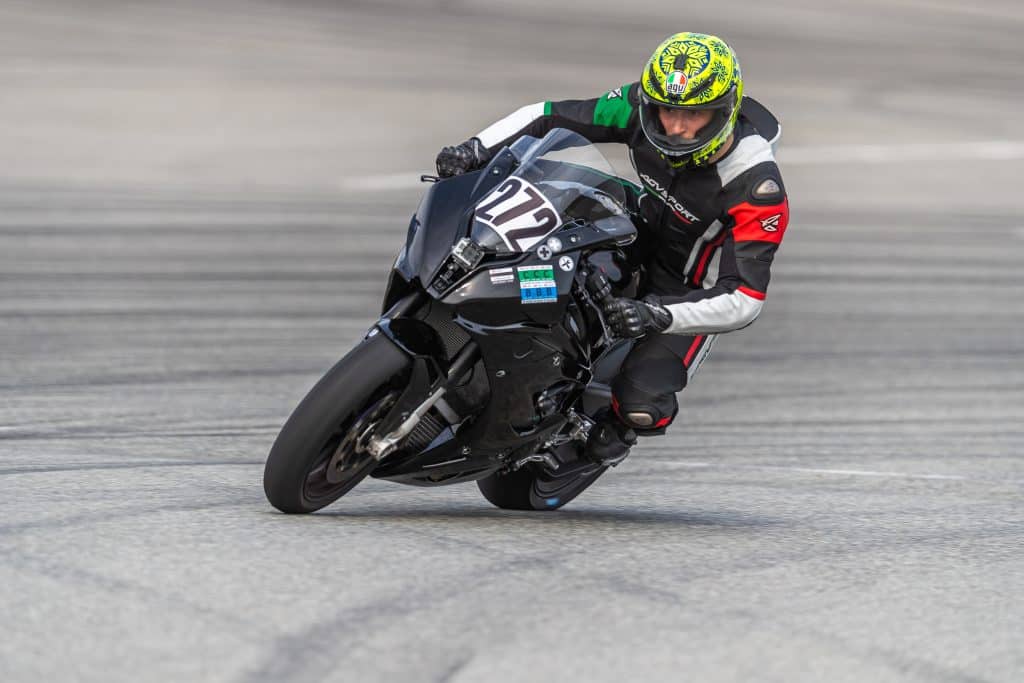
A tire’s load rating appears as a two-digit code on the sidewall of the tire, indicating how much weight the tire can handle. Good quality tires typically range between 58 and 75, corresponding to Gross Axle Weight Ratings (GAWR) of 236 kg (520 lbs.) and 387 kg (853 lbs.) respectively. Yes, that’s the weight per tire.
Maximize Speed Capabilities with Proper Speed Ratings
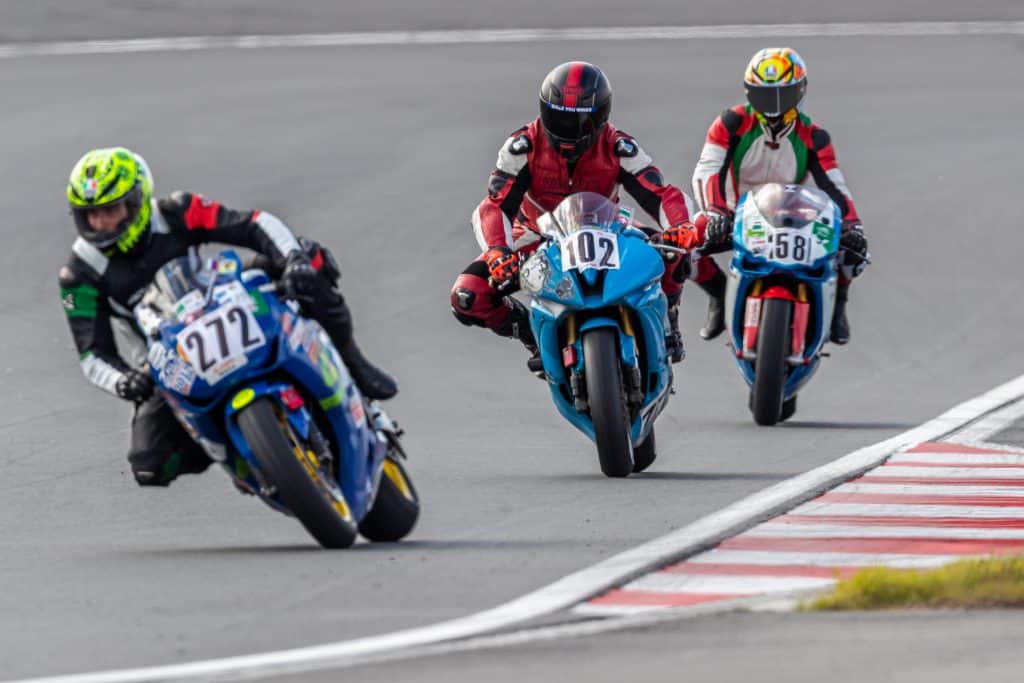
Some tires may have a letter W, Y, or Z in the sizing code. Letter W indicates the tire is rated for a top speed of 168 mph, Y pushes it to 186 mph, and Z often denotes speeds higher than 149 mph — but it can also sometimes mean the same as a Y rating, depending on the manufacturer. Be sure to confirm the rating for your specific tire.
All of my top 5 picks are speed-rated W, meaning the maximum speed allowed is 168 mph/270 kph.
Match the Tires to the Motorcycle
Always double-check tire sizes when ordering to ensure they are a perfect fit for your wheels, both front and rear. A typical tire size is indicated as “120/70 ZR17,” where 120 stands for the width of the tire in mm, 70 is the profile or aspect ratio (height of the tire as a percentage of its width), ZR is the speed rating, and 17 is the diameter of the rim in inches.
Consider Cost-Effective Options for Your Budget

The cost of tires is a big chunk of a motorcycle owner’s running expenses, especially if you ride as frequently as I do. There are quite a good number of tires that are affordable and still cover a considerable distance, striking a balance between performance and lifespan, thus giving you better value for your investment. Then there are the premium kinds, which can be pricey but are still worth every dime.
Top 5 Best Sportbike Tires for Track and Street in 2025
| Tire Model | Category | Front Maximum Load Capacity | Rear Maximum Load Capacity |
|---|---|---|---|
| Dunlop Sportmax Q3+ | Best All-Round | 55 (max 481 lbs.) | 75 (max 855 lbs.) |
| Michelin Pilot Power 2CT | Best Handling | 58 (max 520 lbs.) | 73 (max 805 lbs.) |
| Pirelli Diablo Rosso III | Best All-Weather | 58 (max 520 lbs.) | 73 (max 805 lbs.) |
| Metzeler Sportec M7 RR | Best Beginner-Friendly | 54 (max 467 lbs.) | 66 (max 661 lbs.) |
| Bridgestone Battlax Hypersport S22 | Best Track | 58 (max 520 lbs.) | 75 (max 855 lbs.) |
In today’s vast market, I understand the challenges of navigating numerous options. And in my reviews, I’ll only recommend tires I’ve personally encountered and tested because I firmly believe in imparting knowledge grounded in firsthand encounters rather than relying on mere hearsay. My goal is to provide you with valuable insights that only time and experience can refine.
Over the last five decades, I’ve owned more than 15 sport bikes, from my first classic Italian Malaguti to the sleek Kawasaki Ninja 400, the latest addition to my collection. And when it comes to the best tires for sport bikes, I’ve had hands-on experience with the following 5 tried, tested, trusted sets:
1. Dunlop Sportmax Q3+: Best All-Round
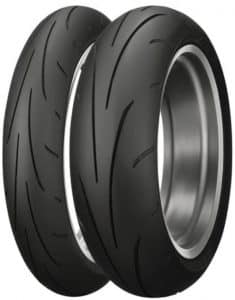
| Specifications | Pros | Cons | ||
|---|---|---|---|---|
| ● Rear Tire Width (mm): 140, 150, 180, 190 ● Available Aspect Ratios (Rear): 50, 55, 60 ● Rim Size (in): 17 ● TT (Tube Type) or TL (Tube Less): TL ● Tire Compound Front/Rear: Purely Silica-Based Compound | ✔ Exceptional grip in all conditions ✔ Precision on twisty roads ✔ Rapid warm-up for instant confidence ✔ Effortless turn-in and reliable feedback | ✘ Tread grooves prone to cracking, leading to air loss ✘ A bit slippery when cold |
In 2013, Dunlop revolutionized the sportbike tire landscape with the Q3. Fast forward to 2017, the Q3+ emerged, showcasing Dunlop’s relentless pursuit of perfection. Despite the subtle name change, the Q3+ underwent a groundbreaking transformation, with over 80% of the tires redesigned. The result? A tire that not only boasts confidence-inducing Carbon Fiber Technology but also incorporates a new silica compound in the center tread, extending its lifespan beyond the 4,000-mile mark—a substantial 30% increase compared to its predecessor.
Innovative Construction, Enhanced Grip
While the tire profile remains consistent, the new construction and compound deliver an additional 2.5% to 6% contact area, courtesy of multi-tread technology with a center tread infused with silica and grippier, softer rubber compounds on the shoulders. Despite the subsequent releases of Q4 in 2018 and Q5 in 2022, the Q3+ remains my top choice. Its unparalleled versatility and ability to offer more spirited riding miles for your investment set it apart.
Made With Precision in the USA
The Dunlop Q3+ is produced in the U.S.—yes, that is important for many of us. It means the tire is made with pedigree, on the same line in their factory in Buffalo, New York, right alongside their exclusive racing breeds.
Unbeatable Value for Exceptional Performance
But perhaps what makes this tire stand out for me has to be the new Intuitive Response Profile™ (IRP) technology, which first shows up with the “+”, putting it right up there with the likes of Michelin Power 5 when it comes to sporting action requiring nimble handling. In the same breath, it will outperform the affordable Continental Sport Attack 2 tire ((single compound).
Tailored Fit for a Variety of Bikes
Recognizing the uniqueness of every motorcycle, Dunlop offers the Q3+ in a diverse array of sizes. From 600cc and 650cc bikes with [Front] 120/60ZR17 and [Rear] 160/60ZR17 to sport bikes below 400cc like the KTM 390 Duke, BMW G310R, and KTM RC 390 with [Front] 110/70ZR17 and [Rear] 150/60ZR17, Dunlop ensures a tailored fit for various riders. These size options are readily available, catering to a wide range of preferences.
Experience the Thrill, Unleash the Power
And so, whether you’re weaving through bustling city streets or mastering challenging racetracks, the Dunlop Q3+ tires deliver unmatched grip, unwavering durability, and exhilarating excitement, making every ride a pulse-quickening adventure.
These sentiments are echoed by Buckley, Senior VP of Sales and Marketing at Dunlop Motorcycle Tires, who remarked,
“MotoAmerica racing in 2025 has been some of the most exhilarating we’ve witnessed in years, with our tire offerings setting lap records!”
Today, experience the thrill with Dunlop Q3+ tires — where performance meets endurance, and every ride becomes a captivating story.
2. Michelin Pilot Power 2CT: Best Handling
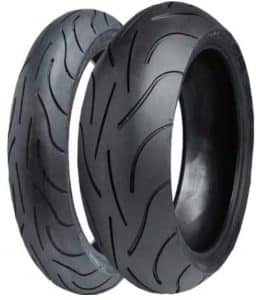
| Specifications | Pros | Cons | ||
|---|---|---|---|---|
| ● Rear Tire Width (mm): 150 to 190 ● Available Aspect Ratios (Rear): 50, 55, 60 ● Rim Size (in): 17 ● TT (Tube Type) or TL (Tube Less): TL ● Tire Compound Front/Rear: Dual Tire Compound | ✔ Ideal for street and canyon rides ✔ Heat up time is good ✔ Impressive grip in corners ✔ Absorbs road issues well | ✘ Tread wears out relatively faster ✘ Falls slightly behind Dunlop Q3 in terms of grip |
The PP2CT is one of the most widely discussed sportbike track and street motorcycle tires online. You almost forget it’s a MotoGP-derived Michelin, and in no shape or form is it cheap! 15 consecutive times, Michelins have taken the MotoGP podium, solidifying its position as the undisputed leader in the industry.
Now, add Michelin’s proprietary 2 Compound Technology to their already phenomenal Pilot Power Range, and you get a tire that can handle canyon carving and a 51.2-degree sweeper at the Laurens Proving Grounds (LPG) in Upstate South Carolina with the same level of competence.
Ready When You Are
These rubbers require minimal warm-up time, possibly owing to the high hysteresis of the soft rubber compound, acting as an integrated tire warmer. The way this tire is built offers exceptional tread life and straight-line stability, which gives you peace of mind, confidence, and a slightly delayed but accurate feel for the road or track surface.
Come Rain Or Shine
Part of why I love PP2CT is that it crosses over to the sport touring category, delivering many miles of spirited riding and pure enjoyment of the two-wheeler rodeo. And in case the road ahead turns cold and wet, you can count on the silica infusion to provide the same grip and progressive responsiveness of warm rubber on hot asphalt. Talk about versatility!
Better Than Stock Handling
I also like that these Michelin tires don’t get in the way of handling. They are so neutral that you could swear they came stock with almost every motorcycle they fit. Unlike other tires that disrupt handling with an early tip-in mid-turn, the Pilot Power 2CT ensures a stable ride because, hello, high sides are no fun, right?
I found this tire to have a track-ready grip on tap, which gave me the push to ride outside my comfort zone on several occasions. And while it might not match the pavement grip of specialized race tires like the Michelin Power Performance Slick Soft, it compensates with its durability, negating the need for tire warmers and outlasting its counterparts in the long run.
3. Pirelli Diablo Rosso III: Best All-Weather
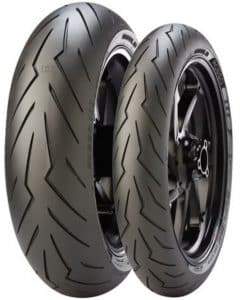
| Specifications | Pros | Cons | ||
|---|---|---|---|---|
| ● Rear Tire Width (mm): 140 to 240 ● Available Aspect Ratios (Rear): 45, 50, 55, 60, 70 ● Rim Size (in): 17 ● TT (Tube Type) or TL (Tube Less): TL ● Tire Compound Front/Rear: Bi-Compound Rubber | ✔ Good stickiness in curves ✔ Suitable for both street riding and track days ✔ Maintains consistent performance even in changing weather conditions ✔ Precise Feedback for a better understanding of road conditions and tire grip | ✘ Wears out relatively quickly ✘ Uneven front tire wear results in a conical shape due to faster wear on the sides |
The aptly named Diablo Rosso III is the speed devil’s little secret when you are shopping for a sporty tire that you can absolutely punish on the road. The key highlights of the III are Pirelli’s Functional Groove Design and Enhanced Patch Technology, both of which make the tire viable for wet and dry road conditions.
An upgrade from the Rosso II, the III features nearly 10% fewer grooves on the front and 8% on the rear, expanding the contact patch area by a substantial 30%. I also noticed that the front tire sports a 3mm thicker sidewall, ensuring integrity under intense cornering and braking pressures.
A Legacy of Racing Expertise
For the last 12 years, the World Superbikes has been riding on Pirellis, and you bet their expertise in making spec tires for this global arena has trickled down to their road-going Diablo Rosso II, III, and IV tires. Their commitment, encapsulated in the motto ‘We sell what we race, we race what we sell,’ echoes AGVSPORT’s own ethos of being ‘designed by riders for riders,’ don’t you think?
Track-Tested, Road-Ready
Departing from the low race profile, the Diablo Rosso III adopts a multi-radius design with increased profile height, which means easier rolling from side to side as you enter opposing curves. The rear has a Bi-Compound construction–no surprises there–meaning it has two rubber infusions and densities to optimize performance at different lean angles.
Softer But Robust ‘Chicken Strips’
The Diablo Rosso III strikes a balance between wear resistance and traction. With a 75% center patch infused with silica, wear is minimized, and grip is maximized when riding upright on wet pavement. The remaining 25% on either side, often humorously referred to as ‘chicken strips’, utilizes a softer carbon-black and resin compound, providing essential traction when leaning into curves.
Riding the Edge: Challenges and Rewards
Something I didn’t like about this set is the vague feeling of lack of feedback from the front, perhaps because of the thicker walls. I also feel the Dry Grip edges work best on a dry surface, so you shouldn’t be pushing it too far in the rain, or you risk a spill. Not that I don’t trust Pirelli’s ever-present grip, but, you know. Despite these nuances, Pirelli’s unwavering grip technology ensures an exhilarating ride, toeing the line between challenge and reward.
4. Metzeler Sportec M7 RR: Best Beginner-Friendly
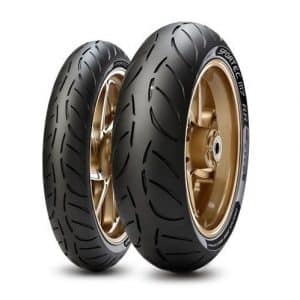
Metzeler Sportec M7 RR: Buy on RevZilla | Amazon
| Specifications | Pros | Cons | ||
|---|---|---|---|---|
| ● Rear Tire Width (mm): 150 to 200 ● Available Aspect Ratios (Rear): 50, 55, 60 ● Rim Size (in): 16 & 17 ● TT (Tube Type) or TL (Tube Less): TL ● Tire Compound Front/Rear: Dual-Compound (40%-20%-40%) | ✔ Confidence-boosting ✔ Excellent performance in variable weather conditions ✔ Heats up rapidly, providing a rubberband-like grip for confident handling ✔ Maintains stability and grip even at very high speeds and long distances | ✘ Reduced grip on snowy surfaces ✘ Might wear out slightly faster in very high temperatures |
Metzeler, renowned for its exclusive focus on motorcycle tires, offers the Sportec M7—a successor to the aging but popular M5 SuperSport street tire, reflecting their expertise. While I’m familiar with the Racetec RR K1, K2, K3, and the Roadtec 02, I don’t find any of these suitable for both track and road use in rainy conditions.
Why? The M7 pays homage to racing memories from the ’80s and ’90s, offering a wide margin of error before losing traction. This characteristic also makes it ideal for beginner and intermediate riders not yet familiar with grip limits.
Born To Race The Streets
Developed using data from prestigious road racing events like the Isle of Man TT and the North West 200, this tire competes favorably with pricier options, such as the Dunlop Q3. It delivers stability and precise handling at moderate to high speeds. While its sidewalls are slightly less robust, leading to occasional squirming under heavy braking, the M7 provides early warning signals through subtle handlebar wiggles.
Wet or Dry, the Grip Is Consistent
Metzeler designed these tires with a keen focus on wet conditions. The front tread has been increased by 15%, utilizing a 100% silica compound. Meanwhile, the rear maintains a 70% silica middle for wear resistance and 100% on the shoulders for grip. On wet tracks, they inspire confidence, making turns slightly easier. But I tend to err on the side of caution, navigating tighter curves at least 10 mph slower just to preserve my AGVSPORT Monza racing leathers in pristine condition.
A Balance of Performance and Precision
While making turns might be marginally easier with the M7, it’s a close competition with the Q3s, and I can’t definitively say which one triumphs. If you’ve discovered the grip limit on these, please do share your story – after all, in the world of motorcycle tires, the quest for the perfect balance of grip, speed, and safety continues, and experiences shared are lessons learned.
5. Bridgestone Battlax Hypersport S22: Best Track
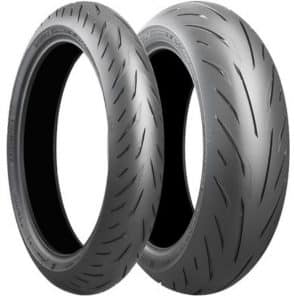
| Specifications | Pros | Cons | ||
|---|---|---|---|---|
| ● Rear Tire Width (mm): 140 to 240 ● Available Aspect Ratios (Rear): 50, 55, 60, 70 ● Rim Size (in): 16 & 17 ● TT (Tube Type) or TL (Tube Less): TL ● Tire Compound Front/Rear: Dual (3LC)/ Triple (5LC) | ✔ Provides excellent grip even in conditions below 45°F ✔ Suitable for both aggressive canyon carving and freeway commuting ✔ Significantly longer lifespan compared to other high-performance options ✔ Consistent grip even in light rain | ✘ Slightly more expensive than budget options ✘ Might not offer the same level of grip and confidence in heavy or prolonged wet conditions |
You guessed it right, the S in S22 stands for Sport. Bridgestone, a powerhouse in automotive, aviation, and motorcycle tires, excels in creating high-performance motorcycle tires for both the track and spirited street riding. And the S22, succeeding the acclaimed Battlax Hypersport S21, aims to enhance wet and dry performance without compromising its lifespan.
Key upgrades include improved water dispersion grooving (enhanced land-to-sea ratio) and 25% more silica than its predecessor, enhancing traction in slick and wet conditions.
Well-Behaved and Grippy
Tailored for both sport and street riding, the S22 employs a robust mud-tire compound and soft yet rigid shoulders to sustain grip and offer cornering stability. Having personally tested these on my smaller Ninja 300 (available in smaller sizes for beginner-class Supersport), I can vouch for their strong, consistent, and reassuring grip, particularly on the front tire.
Track-Worthy Performance
The S22 doesn’t merely meet expectations; it surpasses them, delivering exceptional performance on high-performance machines like the BMW S1000RR, Ducati Panigale V4S, and Suzuki GSX-R1000R. Although the market teems with sport-branded street tires, the S22 distinguishes itself as a tire whose true prowess shines brightest on the track rather than public roads. To unlock its full capabilities, booking a session on the track becomes an essential step.
Michael’s Summary and Conclusion
When riders evaluate sportbike tires, the focus typically narrows down to visible wear, brand reputation, size, and specific models. Yet, there’s a critical element, often disregarded except by seasoned racers—the tire’s heat cycles, which is the process of a tire heating up as it’s used, followed by cooling down when it’s not in use.
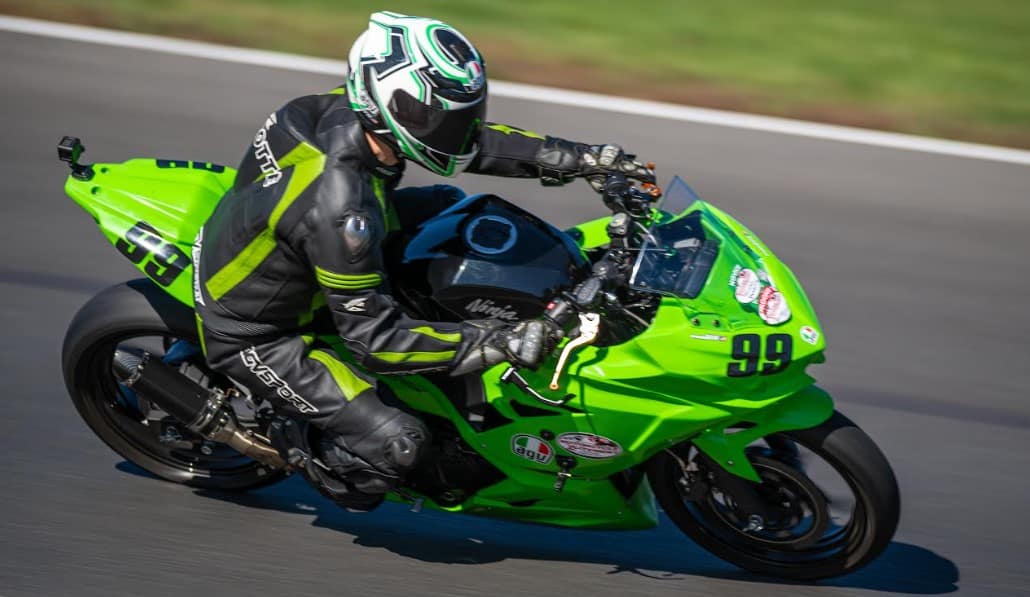
The constant expansion and contraction impact the tire’s internal structure, altering its compound properties and, consequently, its grip and overall performance. And so, regardless of the tire’s brand prominence or price tag, its age and usage profoundly influence its performance. Even a premium tire can lose its original grip due to heat cycling, significantly impacting both the motorcycle’s performance and the rider’s safety.
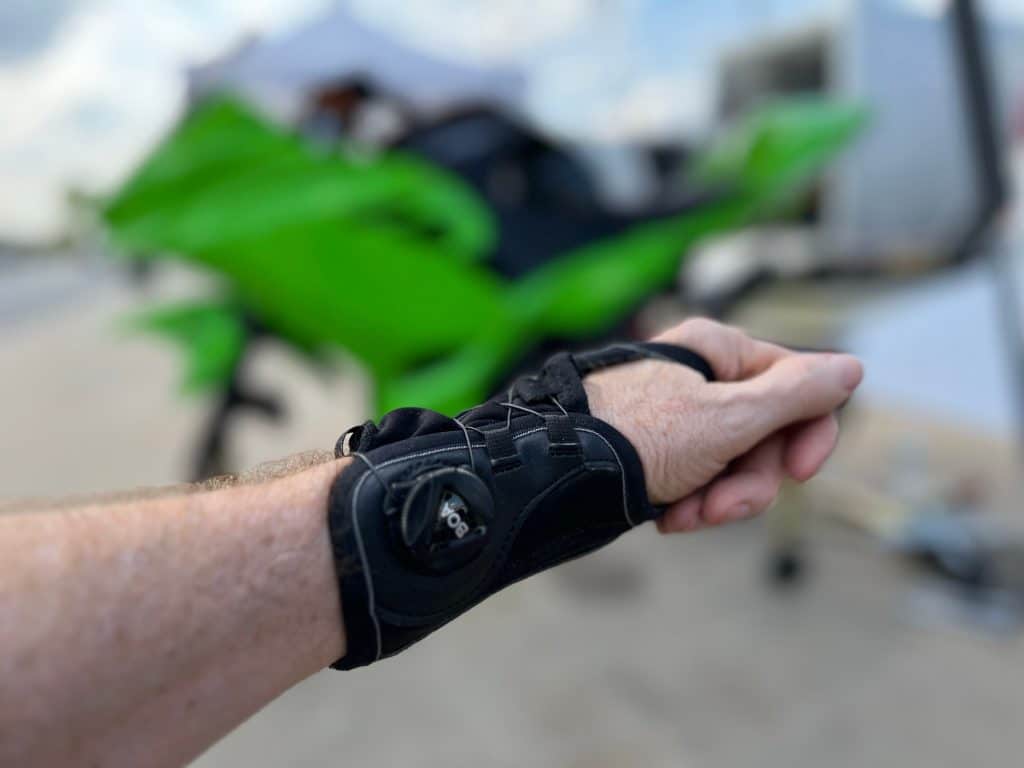
My firsthand (pun intended) encounter with this issue occurred during a track day at Summit Point Raceway in West Virginia last October. Despite having sufficient tread, the tires’ age and numerous heat cycles likely compromised their gripping capabilities. The incident emphasized the importance of not merely inspecting tread depth but also considering the tire’s age and usage to ensure optimal performance.
Understanding that a tire’s lifespan varies based on its usage—ranging from frequent track days on sport bikes to occasional long-distance rides on touring motorcycles—is vital. In an upcoming article, I plan to delve deeper into this topic, illuminating the nuances of tire longevity and its profound impact on rider safety and motorcycle performance. Stay tuned for valuable insights into this often-overlooked aspect of tire maintenance.
FAQs — I Have the Answers!
Q: What Brand of Motorcycle Tire Is Best?
The top 5 best motorcycle tire brands are Dunlop, Pirelli, Michelin, Metzeler, and Bridgestone. Each brand excels in specific riding conditions, making them competitive choices for various riding styles and preferences.
Q: Which Motorcycle Tires Last Longest?
The Dunlop American Elite Tires last the longest, delivering an average of 12,000 to 15,000 miles of mileage, thanks to their unique design, featuring a hard compound in the center for durability and a softer compound on the shoulders for enhanced traction around corners. This combination ensures a balance between longevity and performance.
Q: How Long Do Sportbike Tires Last?
Sportbike tires last about 5-6 years, with the manufacturers recommending replacement within this timeframe, regardless of remaining tread depth, due to the drying out of the tire’s rubber compounds, which affects performance and safety.
Q: What Is the Best Sport Bike Tire Pressure?
The best sport bike tire pressure for maximum grip and sporty riding is 32 psi front and rear, while for maximum longevity, it’s 40 psi front and 42 psi rear; always adhere to the manufacturer’s recommendations for optimal performance.
Information for this article was partially sourced and researched from the following authoritative government, educational, corporate, and non-profit organizations:
Ni/A












